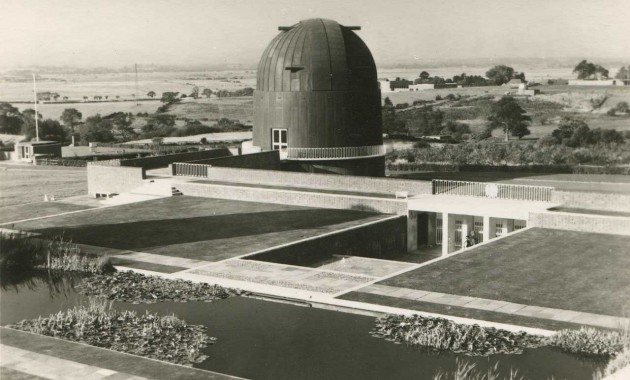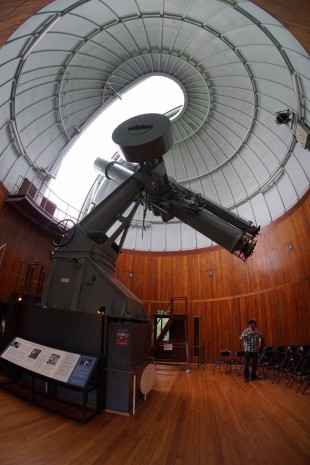…where east meets west
- Home
- Brief History
- The Greenwich Meridian
- Greenwich
(1675–1958) - Herstmonceux
(1948–1990) - Cambridge
(1990–1998) - Outstations (1822–1971)…
- – Chingford (1822–1924)
- – Deal
(1864–1927) - – Abinger
(1923–1957) - – Bristol & Bradford on Avon
(1939–1948) - – Bath
(1939–1949) - – Hartland
(1955–1967) - – Cape of Good Hope
(1959–1971)
- Administration…
- – Funding
- – Governance
- – Inventories
- – Pay
- – Regulations
- – Royal Warrants
- Contemporary Accounts
- People
- Publications
- Science
- Technology
- Telescopes
- Chronometers
- Clocks & Time
- Board of Longitude
- Libraries & Archives
- Visit
- Search
Telescope: The 26-inch Photographic Refractor & the 30-inch reflector of the Thompson Equatorial (1896)
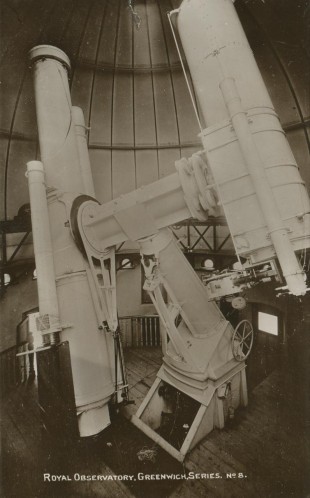
The Thompson Equatorial carrying the Thompson 26-inch Refractor (left) and the Thomson 30-inch Reflector (right). As well as carrying the re-tubed 12.8-inch Merz as its guiding telescope (extreme right), the 26-inch refractor also carried the Thompson Photoheliograph. The Thompson 30-inch Reflector carried the Hodgson 6-inch Refractor as its guiding telescope and a photographic spectroscope. Postcard published by Henry Richardson c.1908
Originally located in the recently completed dome at the top of the South Building, the telescopes were brought into service at the end of 1898. Mothballed in 1939 at the outbreak of war, they remained out of use until the late 1950s.
When they came back into service, it was not at Greenwich, but at the Observatory’s new home at Herstmonceux. There, each was mounted in a separate dome – the 26-inch refractor on the original mounting in Dome E and the 30-inch reflector on a new equatorial mounting in Dome A. The telescopes are still at Herstmonceux and are currently in the care of the The Observatory Science Centre.
Fluid plans and an offer to good to refuse
The early 1890s saw a large number of changes in the planned provision of large equatorials at Greenwich. The changes were partly the result of the engineering prowess of George Airy, who in the late 1850s had designed the mounting for the new Merz 12.8-inch Refractor which had a focal length of just under 18 feet.
In 1859 in his report to the Board of Visitors, Airy stated that the mounting was capable of holding a larger telescope and that ‘it might with some inconvenience carry a telescope of above 20 feet focal length; and, if the regions near the pole were given up, it might carry one still larger.’
In 1885 Christie consulted the Visitors about replacing the 12.8-inch Merz with a new larger refractor with an aperture of 28-inches and a focal length of 28 feet. His proposal was approved by the Board and subsequently by the Admiralty. The object glass was of novel design. By reversing the outer element and altering its separation from the inner one, the telescope was capable of functioning, as needs dictated, as either a photographic refractor or as a visual one. It’s not clear at this point exactly what Christie planned to do with the dismounted 12.8-inch refractor. As things turned out, difficulty in securing glass blanks of sufficient quality for the new refractor meant that the 12.8-inch was able to remain in position until 1891. By then, there had been other developments.
The Lassell Equatorial carrying the 2-foot Lassell reflector was gifted to the Observatory in 1883. The Lassell Equatorial also carried the Thompson 9-inch Photographic Telescope (the Thompson Photoheliograph) which was given to the Observatory by Sir Henry Thompson in 1890. As the Lassell reflector had failed to live up to expectations, Christie decided to mount the Merz telescope in its place. On 23 November 1891, the Merz was dismounted from the Great Equatorial. The following April, the Lassell Reflector was dismounted from the Lassell Equatorial and the Merz Refractor substituted with the Thompson Photoheliograph mounted beneath it.
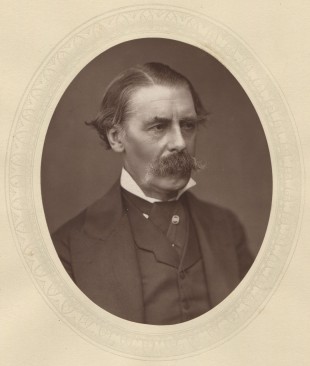
Sir Henry Thompson by Lock & Whitfield. Woodburytype from Volume 6 of Men of Mark, Sampson Low, Marston, Searle and Rivington (1882)
In the meantime, Thompson had approached Christie with a potential offer of £5000 to fund a new telescope. The two met on Thursday 4 January 1894 at Thompson’s club, the Athenaeum, to discuss the matter. This was followed by a 4½ hour visit by Thompson to Greenwich on 13 February. Christie recorded the outcome of the visit in his journal (RGO7/30):
‘He definitely offered a sum of £5000 for a Photo-telescope of say 26 inches aperture & 22ft. 6in focal length similarly mounted to the Astrographic Equatorial but of double the size, to carry the Merz 12¾in refractor as a visual telescope & also the Thompson 9in photoheliograph and authorized me to enter into negotiations with Sir H. Grubb about it.’
What he didn't record was his intention to place the new instrument in the relocated Lassell Dome in place of the Lassell Equatorial.
Christie received the offer in writing on 28 February and forwarded it to the Admiralty the following day. In his letter to Christie, Thompson gives us an insight into his thinking and the state of the public finances:
‘I fear you are not likely to obtain what is really essential from the public purse just now: I venture, therefore, from my strong conviction of the importance of the subject and my deep interest in the advance of Astronomical Science, to offer you at my own charge, the cost of such an instrument as you think will render your equipment in this direction complete and enable you to devote your new and noble 28 inch refractor solely to the purpose to which it is best adapted. After much talk and some enquiry, we have I believe estimated this as amounting to Five thousand pounds, to cover all expenses.’
Having received Admiralty approval to accept the gift, Christie ordered the telescope from Grubb on 5 May 1894. The mounting was to be of modified German form. With a regular German mounting, when the object being tracked reaches the observer’s meridian, it is usually necessary to stop the observations, rotate the polar and declination axes through 180o and then restart the observations. This was inconvenient for visual observing and highly undesirable for photographic purposes where exposures of several hours might be involved. The modified design allowed complete circumpolar motion without the need for such a reversal.
The telescope of a German equatorial is offset from the polar axis and needs to be counterbalanced. This is normally done using large weights on the other end of the declination axis. In the case of the Thompson Equatorial, the counterbalance was a 30-foot reflector.
Quite when it was decided to substitute a second telescope for the counterweight is currently unclear. The first the Board of Visitors heard about it, at least on a formal basis, was in the annual report, written on 11 May 1896, when Christie told them:
‘Sir Henry Thompson has completed his valuable gift by the addition of a Cassegrain reflecting telescope of 30 inches aperture, to be carried in place of the counterpoise at the other end of the declination axis.’
However, correspondence between Christie and Grubb shows that Christie had asked for the telescope to be designed so that a 30 or 36-inch reflector could be added and that this was being discussed by them as early as March 1894, while the specifications for the 26-inch Refractor were still being drawn up (RGO7/39). As well as corresponding on the matter, the two also discussed if face to face as his Journal entry for 4 August 1894 shows:
‘Sir Howard Grubb discussed mounting of 26in. Thompson photo. equatorial. It was arranged that the 30in reflector should be mounted on other end of decn. axis with its axis 6ft from centre.’
It’s not clear exactly how the plans for procuring the 30-foot reflector evolved nor quite how Christie had originally planned to pay for it. He may have had in the back of his mind Ainslie Common’s offer, back in 1890, to figure a new 30 or 36-inch mirror for the Lassell telescope ‘at an inconsiderable expense’ (RGO7/37).
His journal entry for 30 January 1895 sheds some light on the matter:
‘Mr. Common came to discuss mounting of the 30in oblique Cassegrain which he proposes to make for the Obsy. on the Thompson photo-equatorial.’
as does the later entry of 4 May:
‘Sir H. Thompson & his son came down in afternoon to see model of Photo. Equatorl. with 26in refractor & 30in oblique Cassegrain reflector. Sir H. T. approved of the reflector being added on the understanding that he paid Mr Common’s out of pocket expenses, not exceeding £200, Mr Common having offered to figure it giving his own time. There is an estimated balance of £500 out of the £5000 to cover cost of reflector & tube &c’
From the sound of it this is the first that Thompson knew of Common’s involvement with the 30-inch Reflector. His approval for it to be carried on the equatorial on condition that he pay Common's out of pocket expenses was not surprising as he undoubtedly would have wanted the whole instrument to bear his name and his name alone. Further investigation is required to discover whether the suggestion to add the reflector came from Grubb, or Christie, or Common (who had become a member of the Board of Visitors in May 1894, was independently wealthy, and was known for his skill in figuring large mirrors) ... or perhaps from somebody completely different! It would also be interesting to know what Grubb thought about Common being given responsibility for figuring the mirror rather than himself.
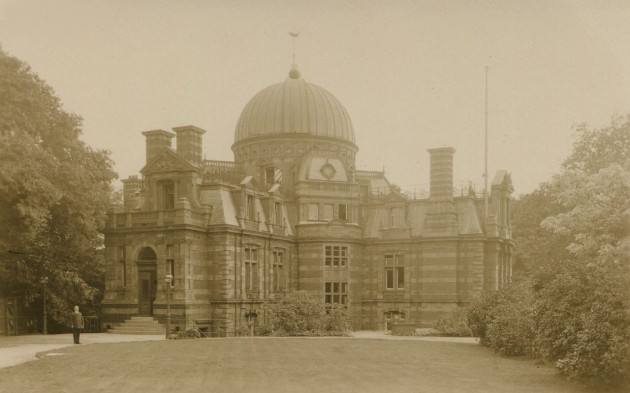
A 1920s view of the dome at Greenwich housing the Thompson Equatorial. From a postcard published by Royal Observatory, Greenwich
Cost versus efficiency and usefulness
Although Thompson’s offer of £5,000 was undoubtedly generous and Christie had a free hand in specifying the dimensions of the new refractor, in reality his hands were tied.
The new telescope needed to be housed and there was no money for a new building. Even if there had been, there was no space left on the site to put one. The dome at the top of the building then under construction was the obvious place to put it. Its diameter of 30-feet constrained the overall length of the new telescope. Although there were undoubtedly advantages of having a telescope with double the dimensions of the Astrographic, a telescope with a longer focal length might have been desirable if the dome had been larger.
The cost of providing the reflector instead of a counterweight for the refractor though not insignificant would have been relatively small compared to the cost of setting up a new reflector on its own mounting in its own building. The downside of mounting the two instruments together was that it was not possible to use them both at once.
While Thompson provided the capital cost of the new telescopes, he did not pay towards their running costs. The Admiralty was reluctant (as always) to provide much by way of additional staffing. Christie did manage to get some concessions, but it is doubtful if he would ever have had the staffing to run a full programme on both telescopes had they been in separate domes.
Christie's description of the instruments
Unlike Airy, who published a full description of all the large telescopes he commissioned (with the exception of the Sheepshanks Equatorial), Christie did not publish a full description for any of his.
Following Airy’s example, Christie did however write a short or very short description of each, which was re-published each year (sometimes with modifications) in the annual volumes of Greenwich Observations. The following is transcribed from the volume for 1908:
‘The Thompson Equatorial, made by Sir Howard Grubb. – This instrument, carrying a 26-inch photographic refractor and a 30-inch reflector on the same mounting, was presented to the Observatory by Sir Henry Thompson, and was brought into use at the end of 1898. It is erected on the central tower of the New Observatory building under the 30-feet dome, and is approximately 350 feet south and 224 feet east of the centre of the transit-circle. The equatorial mounting, which is of the German form, modified to allow of complete circumpolar motion without reversal, carries on one end of the declination axis the 26-inch photographic refractor, the Merz 12¾-inch refractor (used as a guiding telescope), and the 9·inch photoheliograph; and on the other end the 30-inch Cassegrain reflector (made by Dr. Common), with a 6-inch refractor as a guiding telescope.
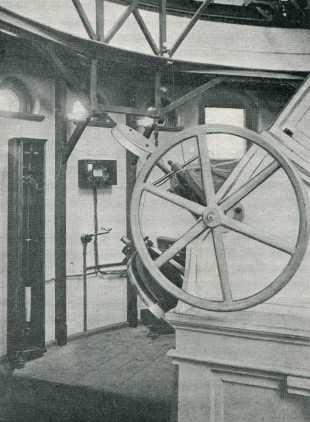
The control pendulum (left) at the base of the Thompson Equatorial. Originally published in The Leisure Hour in 1898, but reproduced here from Maunder's The Royal Observatory Greenwich (London, 1900)
The instrument is driven by a clock with electrical control similar to that of the Astrographic Equatorial.
The 26-inch Refractor is a photographic telescope of 26 inches (0.66 metre) aperture and of 22 feet 5 inches (6.83 metres) focal length, so that its scale is double that of the Astrographic refractor, and one millimetre on the photographic plate represents 30.2". The breech end of the instrument is arranged for a plate-carrier taking photographic plates 12 inches square, suitable adapters being inserted when smaller plates are used. The breech end is also arranged to carry a camera-box, 33inches in length, fitted with a negative enlarging lens, 1.45 inches in diameter, and 3.3 inches in focus, and with a rapid exposing shutter, for photographing sun-spots and other objects on an enlarged scale. When used for this purpose, a diaphragm carrying a roller spring blind is placed before the object-glass, so that the sun’s light may only be permitted to fall on the object-glass immediately before the exposure of the plate is to be made.
The aperture is usually stopped down to 12 inches. The image of the sun in the primary focus of the telescope is 2.5 inches in diameter at mean distance, and this is enlarged 12 diameters, i.e. to a scale of 30 inches to the solar diameter, for the image formed on the photographic plate. The exposing shutter is of the same form as that used in the Thompson Photoheliograph (vide infra). The plate-carrier for the camera-box is constructed to take plates 10 inches by 12inches or, by use of suitable adapters, of smaller sizes. The whole sun is, therefore, not photographed at one time, but only limited areas; generally a single spot-group of special size or interest.
The 30-inch Reflector. – This instrument was constructed under the supervision of Dr. Common who undertook the figuring of the mirrors. It may be used as a simple reflecting telescope for obtaining photographs in the principal focus, or as a Cassegrain. The mirrors are made of silver on glass, the concave being of 30 inches diameter, with a circular hole of 6 inches diameter. The weight of the mirror is 265 lbs., the glass of which it is composed being 4 inches thick. When not in use, it is covered by a plate-disc, with a hinge on one side which allows of it being turned so as to lie along the telescope tube (made D-shape to receive it) when observations are taken. The focal length of the large mirror is 3.48 metres or 11 feet 5 inches, so that 1mm, at the principal focus corresponds to 59.3”. Two convex mirrors of focal lengths 24 and 38 inches are provided, the equivalent focal lengths of the combinations being 76 feet and 49 feet respectively.’
Christie also included a description of the following which are omitted in the transcription above as they are described elsewhere on the website:
- The two guiding telescopes: the 12.8-inch Merz Refractor carried by the 26-inch Refractor and the Hodgson 6-inch Refractor carried by the 30-inch Reflector (mounted September 1898 (RGO39/10/94)).
- The Thompson Photoheliograph which was carried by the 26-inch Refractor
What Christie did not describe were any details of the spectroscope visible in the photograph below.
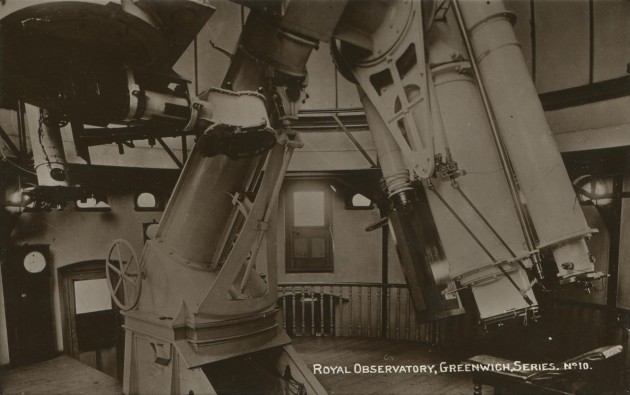
In this view, the clock Dent 2016, which kept sidereal time, can be seen on the left. The top of the case containing the control pendulum (shown in the image above this one) can just be made out behind the base of the telescope (under the circular window). Slightly above and to the left of the door in the centre, the spectroscope attached to the 30-inch Reflector can be seen sticking out sideways from the telescope. Postcard published by Henry Richardson, in around 1908
On 15 April 1897, The Times of London published an article about the Equatorial. It was written with the help of Christie and contains information not generally published elsewhere. From it, we learn that the whole instrument weighed some ten to twelve tons, with about half of that being accounted for by the moving parts. We also learn that the object-glass in its cell weighed about 350 pounds, the flint disc being 168 pounds and the crown 92 pounds. The attached spectroscope had a weight of 180 pounds and the whole instrument was bedded on an arch joining the tops of two solid piers to which the lower part of the whole building was firmly tied.
An examination of the plans of the building’s central octagonal tower, reveals an H-shaped pier rising up the centre and a pair of short pier stubs extending into the octagon from the wall on the south side that also rise from the foundations. At the level of the floor of the dome two arches bridge the gap between the stubs and the two arms of the H of the central pier.
Building the telescope
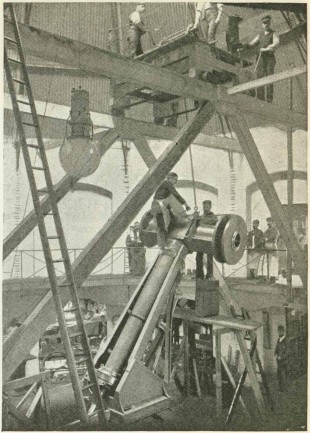
Lifting on the great cross-head of the refractor at the Grubb works. Photo by Sir Howard Grubb. From The Strand Magazine, Volume 12 (1896)
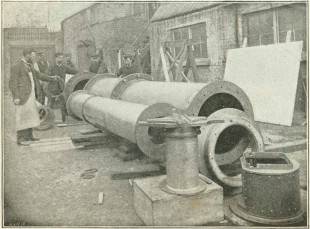
Putting together the tubes of the refractor at the Grubb works. Photo by Sir Howard Grubb. From The Strand Magazine, Volume 12 (1896)
When the telescope was ordered, Grubb gave a delivery time of 12 months from the delivery of the glass for the object glass. The flint disc was delivered a few months later in August 1894. An accident in the manufacture of the crown disc delayed its delivery until 19 March 1895. The manufacture of the telescope ended up taking slightly longer than originally anticipated. It was almost complete and ready for inspection at Grubb’s works in Dublin by May 1896. Erection at Greenwich began that November 1896, the telescope being ready for use in April 1897. Testing of the 26-inch objective showed there was coma in the images and that this could only be corrected by an alteration in the curvature of the surfaces. The object-glass was sent back Dublin for refiguring in August 1897, being returned to Greenwich on 16 May 1898. Meanwhile, it was found that the mirror of the 30-inch reflector supplied by Common had a focal length greater than the tube had been designed for the consequence of which was that it was not practicable to take photographs with it at the primary focus. Common proposed to supply a replacement with the correct focal length of 11 feet 3 inches. In the event, the replacement, which was supplied on 1 September 1898, had a focal length which was two inches greater. Various other minor adjustments and alterations were also made.
Observing programme
The intention here is to give a flavour of how the telescopes were used rather than a fully inclusive account.
The 30-inch Reflector featured in the press on three memorable occasions. The first was after Philibert Melotte discovered the eighth satellite of Jupiter in February 1908. The discovery, which took a while to confirm, was mentioned by Turner in a letter to The Times published on 13 January 1909 and in a follow up article the following week (on 20 January). The second occasion was later in 1909 when observatories around the world raced each other to be the first to see Halley’s Comet which was due to return after an absence of 75 years. The most accurate prediction of its return to perihelion had been made by Crommelin and Cowell at Greenwich who predicted a date of 16 April (later refined to the early hours of 17 April). In the event, the comet reached perihelion some three days later than predicted.
The third occasion was in 1957 when Chief Assistant, Olin Eggen, was famously photographed preparing the telescope for an attempt at photographing the world’s first artificial satellite, Sputnik 1, which had been launched by the Russians on 4 October.
Although the telescopes were up and running by the end of 1898, Maunder was to comment that by August 1900 regular work with the spectroscope on the 30-inch Reflector had not yet commenced. It quite possibly never did. It seems to have been used for the first time on a fairly regular basis in the summer of 1902 and then seemingly not at all. From 1906 the Astronomer Royal dropped the section in which the observations were reported from his annual report.
In 1924/5, the 30-inch Reflector began to be used for the colour temperature work on stars by comparing their spectra with that of a carbon arc. By a movement of the convex mirror of the telescope through a distance of three inches from the normal position in which a parallel beam was sent though the prismatic camera, a similar parallel beam was sent from a carbon arc mounted on the roof of the Octagon Room. The spectrograph was reconstructed in 1927/8. This use of the 30-inch Reflector ceased in 1934/5 when the programme was transferred to the newly installed 36-inch Yapp Reflector.
In 1988, Michael Lowne published a paper on the object-glass of the 12.8-inch Merz, which since 1897 had been in use as the guiding telescope for the 26-inch Refractor. In the paper, which was titled, The Object-Glass of the Greenwich Great Equatorial Telescope, he included a section on the observing programme carried out with the 26-inch Refractor. This makes interesting reading and is reproduced below:
‘Major programmes at Greenwich included photography of satellites for position (mainly Neptune’s satellite Triton, but those of Mars, Jupiter and Saturn were also studied), contributions to the observations of Eros in 1901 and 1930-31 for the solar parallax determinations, stellar parallaxes, proper motions, and photometry in the Kapteyn Selected Areas. The number of exposures made with the 26-inch at Greenwich is not easy to determine: plates taken with the 30-inch reflector carried on the same mounting were numbered in the same series. Up to the start of the parallax programme in 1911, only about 4000 plates had been obtained with the two telescopes, but by 1939 the total had exceeded 30000 of which probably about 25000 were taken with the 26-inch.
Since re-erection at Herstmonceux the 26-inch has obtained nearly 30000 plates, mainly for parallax and proper motion studies. Other programmes have included the photographic photometry of quasars, and positional work such as the derivation of co-ordinates of secondary reference stars for the determination (on other larger telescopes) of accurate positions for radio sources and quasars. For a short time in the 1970s the Merz telescope was fitted with an autoguider.
The focal length of the 26-inch refractor (6.9 m) is decidedly short for parallax work: that of the Merz is shorter still by about 1.5 m and it is only by the most careful attention to manual guiding by the observers that parallax results comparable in accuracy to those from longer-focus telescopes have been obtained.’
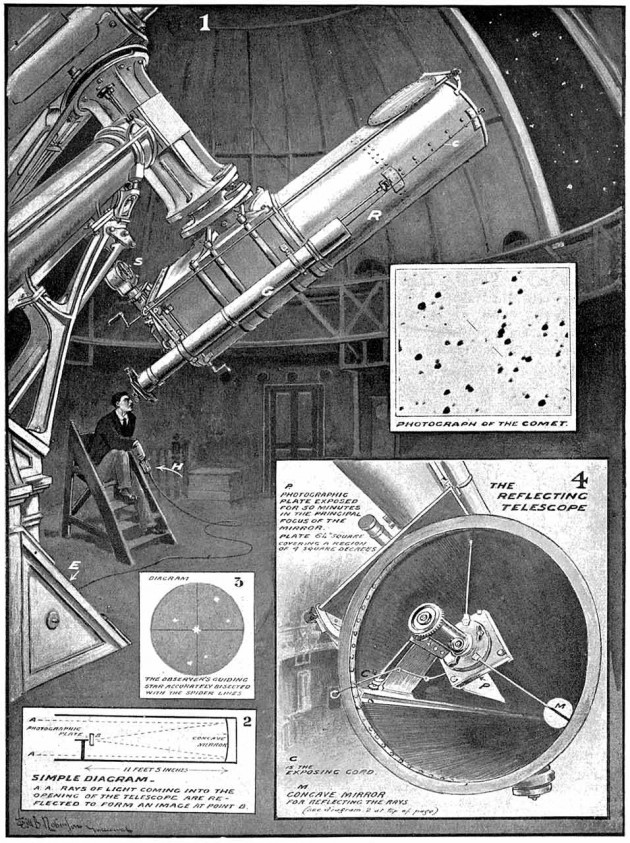
Charles Davidson at the eyepiece of the Hodgson guiding telescope (G) of the 30-inch Reflector (R) during the photographic search for Halley's Comet in September 1909. An electric key (H) in his hand allowed him to finely adjust he rate of the driving clock (E). The exposing cord is marked (C) and the spectroscope, which is not in use, (S). Later copy of an illustration originally published in the 16 October 1909 edition of The Illustrated London News
The 6-inch photographic Franklin-Adams lens
Lent by Franklin Adams in December 1909 and subsequently purchased in 1912/13 (following his death), the 6-inch photographic lens (of 27 inches focus) was mounted on the Thompson Equatorial in 1911/12. On which of the instruments it was carried is not recorded. It remained in place until at least 1914.
Photographs of the telescope in 1929
It is a matter of regret that no systematic photography of the buildings or instruments was undertaken for reference purposes by the Observatory while it was at Greenwich. The General Post Office Research Station at Dollis Hill, which had professional dealings with the Observatory, carried out a number of site visits in the 1920s and took systematic photographs of equipment related to the operation of the time service. Fortunately for those interested in the history of the Observatory, photographs of some the other buildings and instruments were also taken by their photographer. These were inherited by BT. The photographs have now been digitised and are available for use from The BT Digital Archives. Five images relating to the Thompson Equatorial, which were taken on different dates in 1929, are reproduced below.
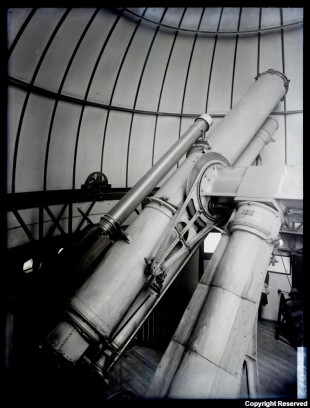
The 26-inch Refractor with the Thompson Photoheliograph above and the 12.8-inch Merz Refractor below. © BT Heritage. Reproduced under the terms of a Creative Commons Attribution-Non-Commercial-ShareAlike (CC BY-NC-SA) licence (see below)
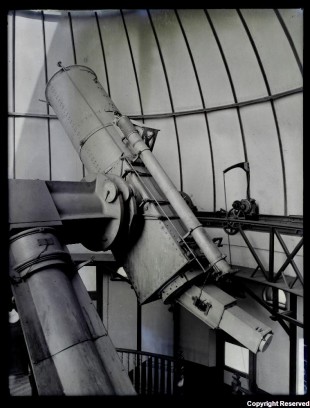
The 30-inch Reflector with the new spectroscope. © BT Heritage. Reproduced under the terms of a Creative Commons Attribution-Non-Commercial-ShareAlike (CC BY-NC-SA) licence (see below)
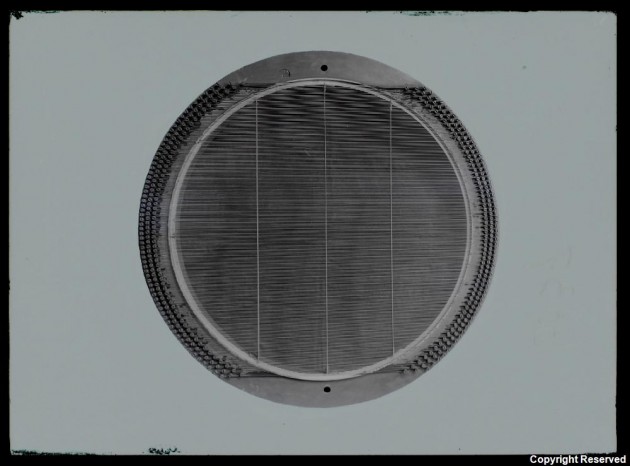
Wire diffraction grating for the 30-inch Reflector. This is believed to be the grating used for the determination of effective wave-length of stars which was made on the suggestion of Hertzsprung and constructed in the Observatory workshop in 1920/21. It was described in the 1921 Annual Report, as being made of steel wire 1.42mm in diameter, the separation between the wires being equal to their diameter. From a single plate, the effective wavelength could be determined with a probable error of ±15A. © BT Heritage. Reproduced under the terms of a Creative Commons Attribution-Non-Commercial-ShareAlike (CC BY-NC-SA) licence (see below)
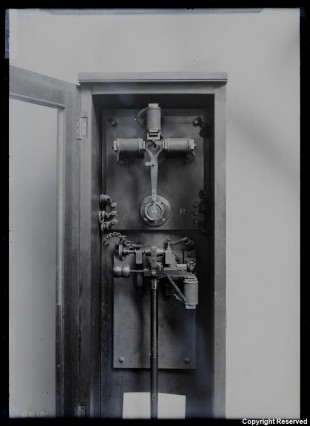
The control pendulum of the Thompson Equatorial. © BT Heritage. Reproduced under the terms of a Creative Commons Attribution-Non-Commercial-ShareAlike (CC BY-NC-SA) licence (see below)
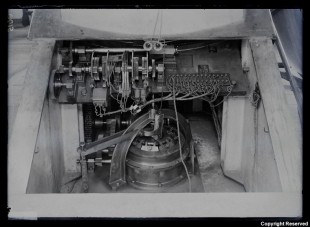
The control mechanism (driving clock) located in the base of the Thompson Equatorial. © BT Heritage. Reproduced under the terms of a Creative Commons Attribution-Non-Commercial-ShareAlike (CC BY-NC-SA) licence (see below)
The modifications of 1935
In 1933, the newly appointed Astronomer Royal, Harold Spencer Jones, informed the Board of Visitors in his annual report, that the output with the 26-inch Refractor had been suffering because of frequent dewing of the object-glass during the winter months and that the proximity of the object-glass to the dome prevented a dew-cap of sufficient length from being fitted.
Dewing must have been a problem from the start, but this is the first time it appears to have been drawn to the attention of the Board. An examination of the photographs above suggests that the telescope had originally been fitted with a short dew-cap, but that this had been removed by 1929. The solution adopted by Spencer Jones was fairly radical.
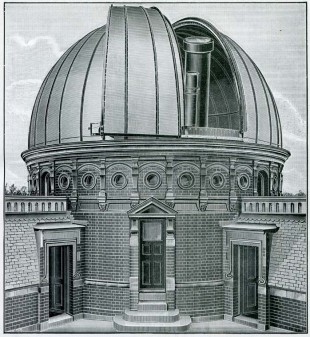
An early external view of the 26-inch Refractor in the dome at Greenwich. Note how close the top of the telescope is to the dome covering. From the Illustrated Catalogue of T. Cooke & Sons (London & York, 1908)
Because the telescope was effectively being lowered in its mounting by two feet, it was also necessary to remove the false floor in the dome (which is visible in some of the images above).
The works meant that the telescope was out of action from 17 June to 21 October. In reporting the changes to the Board of Visitors in 1936, Spencer Jones commented that not only had there been no loss of output for the first time in the winter months due to dewing of the object-glass, but that there was a distinct improvement in the average definition of the photographs as a result of the combined effect of the dew-cap and fan.
Transfer to Herstmonceux
In the early 1930s, soon after his appointment as Astronomer Royal, Harold Spencer Jones, sought to move the Observatory to a new site away from the pollution of Greenwich. With the outbreak of war, the plans were put on hold and the object-glass of the 26-inch Refractor and the 30-inch mirror removed to a place of safety. The building and dome were damaged during a bombing raid on the night of 21–22 October 1940 (RGO107/Laurie Diaries). The damage although considerable was not serious. Further minor damage was caused by a flying bomb that fell nearby on 15 July 1944. Meanwhile, by February 1944, the Admiralty had approved a move in principle. In light of this, it was decided not to spend money on refurbishing the dome at Greenwich.
By 1946 a new site for the Observatory at Herstmonceux had been agreed and by April 1948, both telescopes had been removed from the dome at Greenwich. Although the move to Herstmonceux commenced in 1948, post war austerity coupled with other delays meant that none of the large equatorials from Greenwich were brought into use until the late 1950s. The Equatorial Group consisted of a cluster of six domes labelled A to F. At Herstmonceux, the two telescopes were separated and mounted in different domes. The 26-inch Refractor was re-erected on its original mounting in dome E, with a large counterweight in place of the 30-inch Reflector. The 30-inch Reflector was re-erected in Dome A, on a new fork mounting by Cox, Hargreaves & Thompson, who also re-figured its mirror which was subsequently aluminised at Herstmonceux. The 30-inch Reflector was brought into use in 1957 and the 26-inch Refractor in 1958
By 1959, having discovered that the image quality at the Cassegrain focus of the 30-inch Reflector was ‘rather poor’ and that further tests had indicated that there was nothing wrong with the main mirror, both it and the secondary mirror were sent to Newcastle so that the secondary could be refigured. By 1960, the two mirrors had been returned and the image quality was found to be much improved. Around the same time, tests were carried out on the stability of a steel scaffolding located on the ground floor of the 30-inch dome but extending through the hatches of the upper two floors with a view, if successful, to fitting a coudé spectrograph. Finding that the scaffolding was indeed stable, it was decided to proceed. By 1961, a spectrograph was at the design stage in the Observatory workshop and some of the modifications required of the telescope were underway. By the following year (1962), the telescope had been fitted with a new secondary hyperbola and coudé flats and the spectrograph was under construction. By 1964, the spectrograph had been installed and testing was underway. In his report to the Board of Visitors that year, Woolley was able to write:
‘The coudé spectrograph designed and built in the Herstmonceux Engineering Department, with optics by Grubb Parsons, has been installed on the 30in. reflector in Dome A and aligned and tested. It is intended to use the telescope permanently at the north coudé focus with this spectrograph, thus avoiding the frequent removal, replacement and re-alignment of mirrors necessary with most other coudé telescopes.
The coudé secondary mirror narrows the f/4.5 primary beam to f/47. The returning beam is reflected from the rotating flat at the intersection of the polar and declination axes through an aperture in the side of the telescope tube, travelling northwards and upwards to a fixed flat at the top of a 12ft. tower. From this mirror the converging beam passes vertically downwards to the slit, which is mounted horizontally at a convenient height above the observing floor. The collimator mirror is on the ground floor, 19ft. below the slit, and returns a parallel beam, inclined slightly to the west of the down-coming light, to the plane grating and camera on the mezzanine floor. The camera is an off-axis Schmidt with a double-pass corrector plate attached to the grating. The spectrum is focused on a 7 in. x 1 lin. plate curved to a radius of 32 in. and the dispersion is 10 A/mm in the second-order blue. Widening is achieved by rocking a glass plate just underneath the slit.
Economy in the number of reflections by using a north coudé focus cannot be purchased without cost. In this case the mechanical construction renders certain areas of the sky inaccessible: observations are restricted to objects between declinations -20º and +50º.’
.
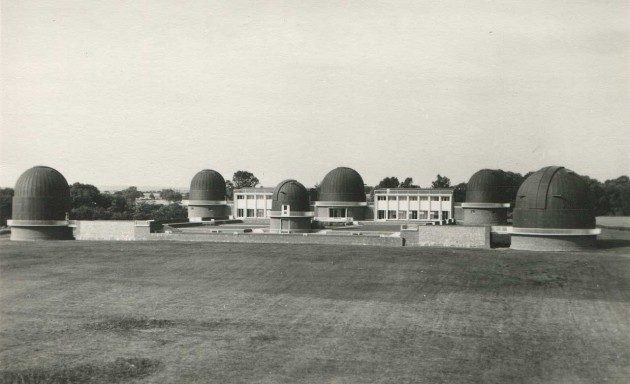
The Equatorial Group at Herstmonceux photographed from the south in about 1959. Dome E containing the 26-inch Refractor is on the left. Dome A containing the 30-inch reflector is immediately to its right. From an old (RGO?) postcard
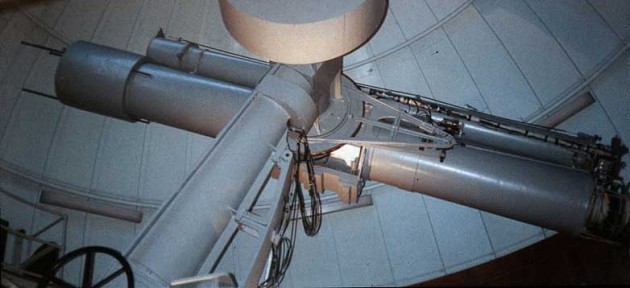
The Thompson 26-inch Photographic Refractor (below) with the 12.8-inch Merz Refractor as its guiding telescope (above) in its dome at Herstmonceux. Although the date of the photograph is unknown, it was probably taken in the 1970s or 1980s. Photo courtesy of Patrick Moore
The telescopes remained at Herstmonceux when the Observatory vacated the site and moved to Cambridge at the end of the 1980s. The Herstmonceux site was sold to James Developments who later went into administration. In early 1993, the Castle was purchased for the Queen’s University of Ontario, Canada for use as an international study centre. The Equatorial Group came back to life in 1995 as The Observatory Science Centre, under the aegis of Science Projects. The two Thompson telescopes are now in their care.
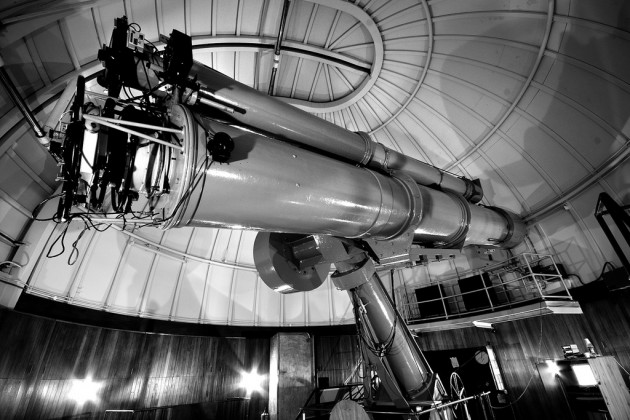
The Thompson 26-inch Photographic Refractor with the 12.8-inch Merz Refractor photographed at Herstmonceux in 2009. Reproduced under the terms of a Creative Commons Attribution-NonCommercial-NoDerivs (CC BY-NC-ND) licence courtesy of Melanie Davies (see below)
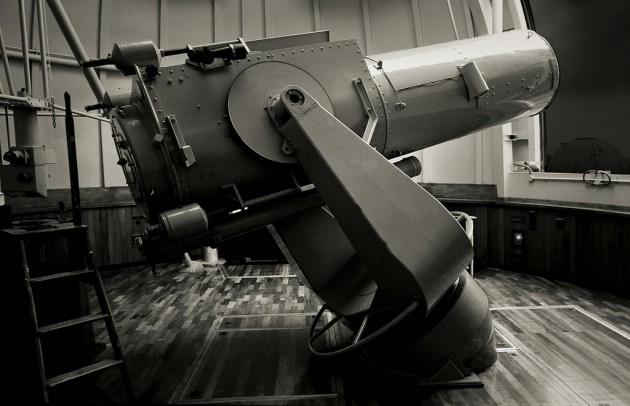
The Thompson 30-inch Reflector photographed at Herstmonceux in 2011. Reproduced under the terms of a Creative Commons Attribution-NonCommercial-NoDerivs (CC BY-NC-ND) licence courtesy of Melanie Davies (see below)
Contemporary accounts
The New Telescope at Greenwich. The Times (London, England), Thursday, Apr 15, 1897; pg. 12; Issue 35178. (1805 words)
Further reading
Sir Howard Grubb. Illustrated Interview from The Strand Magazine, Volume 12 (1896) pp.369–381
Silvering Methods at Greenwich 1900–1956. E.G. Martin. The Observatory, Vol. 84, p. 20-23 (1964)
The Object-Glass of the Greenwich Great Equatorial Telescope. Lowne, C. M. Journal for the History of Astronomy, Vol.19, NO. 3/AUG, P.169, 1988
Victorian telescope makers: the lives and letters of Thomas and Howard Grubb. Glass, I. S. Bristol, UK: Institute of Physics Pub., 1997
Image Credits and licensing arrangements
| Centre | The set of five photographs taken in 1929 (the two telescopes, the control mechanism, the contol clock and the diffraction grating are © BT Heritage. They have been obtained from The BT Digital Archives and are reproduced under the terms of a Creative Commons Attribution-Non-Commercial-ShareAlike (CC BY-NC-SA) licence. They are more compressed than the originals. The levels of the two telescope images have also been adjusted |
|
| 4th from bottom | The Thompson 26-inch Photographic Refractor with the 12.8-inch Merz Refractor at Herstmonceux in the 1970s or 1980s. Photo reproduced from The Patrick Moore Collection courtesy of Patrick Moore |
|
| 3rd from bottom | The Thompson 26-inch Photographic Refractor with the 12.8-inch Merz Refractor photographed at Herstmonceux in 2009. Reproduced under the terms of a Creative Commons Attribution-NonCommercial-NoDerivs (CC BY-NC-ND) licence courtesy of Melanie Davies. For link to original image click here | |
| 2nd from Bottom | The Thompson 30-inch Reflector photographed at Herstmonceux in 2011. Reproduced under the terms of a Creative Commons Attribution-NonCommercial-NoDerivs (CC BY-NC-ND) licence courtesy of Melanie Davies. For link to original image click here | |
| Bottom | The 26-inch Refractor in September 2016. Photo courtesy of Robin Catchpole |
© 2014 – 2026 Graham Dolan
Except where indicated, all text and images are the copyright of Graham Dolan
